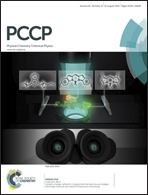Nanoparticle dispersion in polymer nanocomposites by spin-diffusion-averaged paramagnetic enhanced NMR relaxometry: scaling relations and applications†
Abstract
Scaling relationships are identified between NMR longitudinal relaxation times and clay dispersion quality in polymer–paramagnetic clay nanocomposites. Derived from a previously published analytical relationship developed from a lamella-based model, the scaling relationships are based on the enhancement of NMR relaxation rates with increasing exfoliation and dispersion homogeneity. The paramagnetic contribution to the NMR relaxation rate is inversely proportional to the square of the clay interparticle spacing, and directly proportional to the square of the clay weight fraction. These scaling relationships allow the prediction of relative exfoliation of clay particles for a given series of polymer–clay nanocomposites. With independent knowledge of clay exfoliation in a single sample (e.g., from transmission electron microscopy), NMR relaxometry data may be converted into absolute measures of exfoliation. These scaling relations are confirmed with samples of fully exfoliated poly(vinyl alcohol)–montmorillonite nanocomposites, and then used to reveal exfoliation and dispersion quality in a series of nylon-6–montmorillonite nanocomposites. This characterization route is advantageous because NMR relaxometry can more rapidly provide clay dispersion information that is averaged over larger sample volumes than transmission electron microscopy.


 Please wait while we load your content...
Please wait while we load your content...